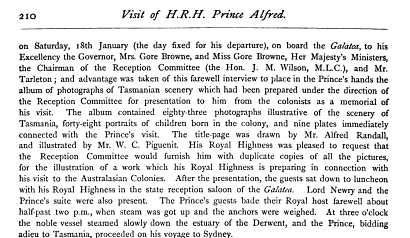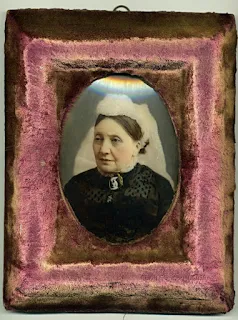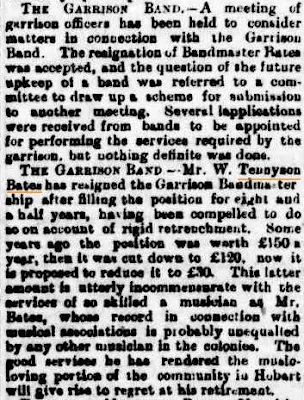NEVIN & SMITH, photographers 1868, Children's portraits
MEREDITH, Mrs Louisa Anne Meredith, lyricist, Children's Song 1868
The firm of Nevin & Smith 1865-1868
Within months of acquiring Alfred Bock's stock-in-trade, equipment, furnishings, lease on the studio and the glasshouse at 140 Elizabeth Street, Hobart, Tasmania at auction in 1865 on Bock's imminent departure for Victoria, 23 year old Thomas J. Nevin continued operating the studio in partnership with Robert Smith under the business name of Nevin & Smith. However, by February 1868, just weeks after the visit of Prince Alfred, Duke of Edinburgh, the partnership was dissolved by Nevin's family solicitor and mentor, the Hon. W. R. Giblin. Robert Smith departed soon after for Goulburn, NSW where he set up a studio in his own name. During their brief partnership, they produced a series of stereographs featuring houses around Kangaroo Valley (Hobart) and fine albumen portraits of children and young adults, including a beautifully composed portrait of Thomas Nevin's fiancee, Elizabeth Rachel Day.
Between 1865 and 1868, the partnership advertised the firm Nevin & Smith with three types of verso stamps. The most rare and unusual is this one printed for the visit to Hobart Tasmania of Alfred Ernest Albert, the Duke of Edinburgh, second son of Queen Victoria, in command of his yacht HMS Galatea, a steam-powered sail-equipped frigate arriving on 6th January and departing on 18th January 1868 for NSW where, on his return to Sydney, he survived an assassination attempt at Clontarf (12th March 1868).

Verso stamped with Royal insignia of three feathers, coronet and Ich Dien;
From Nevin & Smith late Bock's, 140 Elizabeth St. Hobart Town
Subject: young man with full wispy beard, in check-pattern summer jacket
Photographers: Nevin & Smith (Thomas J. Nevin and Robert Smith)
Location and date: 140 Elizabeth St. Hobart, Tasmania, January 1868
Details: lightly hand-tinted albumen photograph in buff carte-de-visite mount
Copyright © The Liam Peters Collection 2010 & KLW NFC Imprint 2020.
The following rare extant examples by Thomas J. Nevin and Robert Smith, held in both public and private collections, were taken during the royal visit in January 1868. They were printed verso with the Prince of Wales' blazon of three feathers and coronet, banded with the German "ICH DIEN" (I serve). Beneath the feathers insignia is the printed wording "From NEVIN & SMITH" with Bock's name and the studio's address.


Subject: young man with full wispy beard, in check-pattern summer jacket
Photographers: Nevin & Smith (Thomas J. Nevin and Robert Smith)
Location and date: 140 Elizabeth St. Hobart, Tasmania, January 1868
Details: lightly hand-tinted albumen photograph in buff carte-de-visite mount
Verso stamped with Royal insignia of three feathers, coronet and Ich Dien;
From Nevin & Smith late Bock's, 140 Elizabeth St. Hobart Town
Copyright © The Liam Peters Collection 2010 & KLW NFC Imprint 2020.
The Children's Album for Prince Alfred
At his final reception, Prince Alfred was presented with an album containing "eighty-three photographs illustrative of the scenery of Tasmania, forty-eight portraits of children born in the colony, and nine plates immediately connected with the Prince's visit" according to the account largely derived from local newspaper articles, printed with the title Narrative of the visit of His Royal Highness the Duke of Edinburgh to the colony of Victoria, Australia, pp 200-210, published in 1868 by John George Knight. The Prince's photograph prefacing this edition showed a Royal preference for a chinstrap beard lightly whiskered around the chin and cheeks.


TRANSCRIPT
... on Saturday ,18th January (the day fixed for his departure) on board the Galatea, to his Excellency the Governor, Mrs. Gore Browne and Miss Gore Browne, Her Majesty's Ministers, the Chairman of the Reception Committee (the Hon. J. M. Wilson, M.L.C.), and Mr Tarleton; and advantage was taken of this farewell interview to place in the Prince's hands the album of photographs of Tasmanian scenery which had been prepared under the direction of the Reception Committee for presentation to him from the colonists as a memorial of his visit. The album contained eighty-three photographs illustrative of the scenery of Tasmania, forty-eight portraits of children born in the colony, and nine plates immediately connected with the Prince's visit. The title-page was drawn by Mr Alfred Randall and illustrated by Mr W. C. Piguenit. His Royal Highness was pleased to request that the Reception Committee would furnish him with duplicate copies of all the pictures for the illustration of a work which his Royal Highness is preparing in connection with his visit to the Australasian Colonies. After the presentation, the guests sat down to luncheon with his Royal Highness in the state reception saloon of the Galatea. Lord Newry and the Prince's suite were also present. The Prince's guests bade their Royal host farewell about half-past two p.m., when steam was got up and the anchors were weighed. At three o clock the noble vessel steamed slowly down the estuary of the Derwent and the Prince, bidding adieu to Tasmania, proceeded on his voyage to Sydney.Source: Page 210, Narrative of the Visit of the visit of His Royal Highness the Duke of Edinburgh...
Narrative of the visit of His Royal Highness the Duke of Edinburgh to the colony of Victoria, Australia by John George Knight. Download pdf here.
Teenager Jack NEVIN 1868
Thomas Nevin and partner Robert Smith may have submitted several portraits for inclusion in the Children's Album to be gifted to Prince Alfred, each bearing the official insignia verso of the Prince of Wales and the wording "FROM NEVIN & SMITH" including these two examples. Younger brother William John Nevin (1852-1891) was sixteen years old in January 1868 when he posed for this photograph taken by his brother Thomas in the studio at the City Photographic Establishment, 140 Elizabeth St. Hobart Town.



Subject: William John Nevin (1852-1891), known as Jack to the family;
also known as Constable John Nevin from 1870-1891
Photographers: Thomas J. Nevin (older brother) and Robert Smith, as the firm NEVIN & SMITH
Location and Date: 140 Elizabeth St. Hobart, Tasmania, January 1868.
Details: verso stamped with Prince of Wales blazon of three feathers, coronet and Ich Dien;
"From Nevin & Smith late Bock's, 140 Elizabeth St. Hobart Town"
Source: Private Collection, Sydney Rare Books Auction, June 2019
The typical pose and dress of young John (William John) aka Jack Nevin, choices made whenever he was photographed while still a youth, were with left arm bent, hand on hip, clean shaven (until his early twenties when he favoured a moustache), a three piece suit with fob chain, and jacket with velvet revers (lapels). The little bowler was brand new, placed next to two decorative pot plants. The decor in the studio at this time - January 1868 - featured the heavy plinth with plaster panels inset with a wreath which Thomas Nevin acquired from Alfred Bock's auction and which appears in one of his photos of the Bayles sisters. The large lozenge patterned carpet softened with white edges and floral centre appears in several of these Nevin & Smith portraits.
The second example (below), also taken especially for the visit of Prince Alfred in 1868 and bearing verso Nevin & Smith's stamp of the Royal insignia of three feathers and coronet banded with "Ich Dien" was more likely to have been included in the album gifted to Prince Alfred as one of the "forty-eight portraits of children born in the colony..." than the print of Jack Nevin who was not locally born, even though he was barely two months old when his parents and three older siblings departed England, arriving in Hobart as free settlers on the Fairlie, 3rd July 1852.
The poor condition of this photograph indicates much handling by its subjects and subsequent generations before arriving at the State Library of Victoria as part of John Etkins' private collection. The reddish colouring of the drape was probably applied by subsequent owners; similar attempts using this particular shade, plus violet and bright red appear on portraits from a contemporary northern Tasmanian family.


STATE LIBRARY OF VICTORIA
[Studio portrait of two children] Nevin & Smith.
Creator: Nevin & Smith, photographer.
Title: [Studio portrait of two children] [picture] / Nevin & Smith.
Access/Copyright: Reproduction rights: State Library of Victoria
Accession number(s):H2005.34/2004 H2005.34/2004A
Date(s) of creation: [ca. 1867-ca. 1875]
Medium: 1 photographic print on carte de visite mount : albumen silver, hand col. ;
Dimensions: 11 x 7 cm.
Collection: John Etkins collection.
Photographer printed on verso: From / Nevin & Smith / late Bock’s / 140 Elizabeth Street / Hobart Town.
Source/Donor: Gift of Mr John Etkins; 2005.
Children's Song of Welcome to Prince Alfred
A choral march was written with lyrics by Louisa Anne Meredith and music by Frederick A. Packer for the occasion. The score was printed with a cover illustration depicting a laurel wreath in green ink encircling the name "Alfred of England", L.A.M. Del. et Lith. and marked with L.A. Meredith's monogram. The inside page was printed as a direct address to Queen Victoria:
To the Queen this choral march, arranged at the desire of Mrs. Gore Browne, and sung by five thousand children on the arrival of His Royal Highness, the Duke of Edinburgh in Tasmania, is respectfully dedicated by Her Majesty's faithful subjects Louisa A Meredith and Frederick A Packer"-


Children's song of welcome to Prince Alfred / words by Louisa. A. Meredith ; music by F.A. Packer.
Author/Creator: Packer, F. A. (Frederick Augustus), 1839-1902, composer.
Publication: Hobart Town : Walch & Sons, [1868?]
Physical description: 1 score (2 unnumbered pages) ; 39 cm.
Notes: "To the Queen this choral march, arranged at the desire of Mrs. Gore Browne, and sung by five thousand children on the arrival of His Royal Highness, the Duke of Edinburgh in Tasmania, is respectfully dedicated by Her Majesty's faithful subjects Louisa A Meredith and Frederick A Packer"--Page 1.
For chorus (SATB) and piano.
Cover illustration depicts a laurel wreath encircling the name "Alfred of England", L.A.M. Del. et Lith.. Marked with her monogram. Wreath foliage in green ink.
Saxe-Coburg and Gotha, Alfred, Duke of, 1844-1900 -- Travel -- Tasmania -- Songs and music.
Royal Tour ((1868 : Tasmania)) -- Songs and music.
Other Authors/Creators:
Meredith, Louisa Anne, 1812-1895, lyricist, artist, lithographer.
Henn, M. L. (M. Louis), active 1867-1886, lithographer.
Record ID: SD_ILS:704850
Archives Office of Tasmania
Link: https://stors.tas.gov.au/ILS/SD_ILS-704850

Triumphal Arch for the Duke of Edinburgh, New Wharf, Hobart, 1868
Rare view of this arch with the greeting "Sailor Prince", echoed in Louisa Meredith's song
Half of stereograph, photographer(s) Thomas Nevin, Samuel Clifford?
Archives Officeof Tasmania
Louisa Anne Meredith (1812-1895)
Distinguished author and illustrator Mrs Louisa Anne Meredith nee Twamley wrote the lyrics to the song of welcome to Prince Alfred, intended to be sung by five thousand children.


TRANSCRIPT
The Children's Song of Welcome to Prince Alfred
Words by Louisa A. Meredith
[These are the four verses: read across first page to second page for 2nd and 3rd lines]
1st: He has come! He has come to us over the sea Our Sailor Prince hail
1st: him hearti... ly Let joy bells ring Shrill welcom ... ing And voices of thousands
1st: glad greeting sing To Alfred of England! Prince of the Sea! Alfred of England! Prince of the Sea!
2nd: He has come over Britain's broad realm of sea To our Southern Isle whose
2nd: warm lo-yal-ty To her now a ... tone On earth's mightiest throne We loving-ly speak to
2nd: her no-ble son Alfred of England! Prince of the Sea! Alfred of England! Prince of the Sea
3rd: He has come, our Prince whose glorious name Echoes great Saxon
3rd: Alfred's fame King, Hero, Sage. Let Histr'y's page Bear record as good
3rd: as great of thee Alfred of England! Prince of the Sea! Alfred of England! Prince of the Sea!
4th: He has come, British cheers to his name have roll'd Thro' realms by that Monarch
4th: Bard of old undream'd unknown. Hark! the loud tone of welcome floats o'er
4th: mountain and tea God bless thee Alfred! Prince of the Sea! God bless thee Alfred! Prince of the Sea.

Recto: Louisa Anne Meredith nee Twamley (1812-1895), author, naturalist, artist and photographer.
Verso: Invitation - not from Mrs Meredith - for an event at Hadley's Rooms, Tuesday 23rd February

Subject: Louisa Anne Meredith nee Twamley (1812-1895)
Photographer: unattributed but possibly W. H. Carl Burrows, Launceston
Location and date: Launceston, Tasmania ca. 1885
Details: hand tinted portrait on oval domed glass, removed here from its pink velvet frame
Copyright © Private Collection of John McCullagh & KLW NFC Imprint 2005-2020.
TRANSCRIPT
Mrs. de Graves and Miss Agnew
request the pleasure of
Mrs Walker's
Company at Hadley's Rooms, on Tuesday
Evening, February 23rd, at 9 o'clock.
This hand painted photograph on glass of Louisa Anne Meredith ca. 1885 bears verso an invitation issued by Mrs de Graves and Miss Agnew to Mrs Walker for an evening event commencing at 9pm held at Hadley's Rooms on 23rd February, 18?? No newspaper search has yet revealed what the event entailed and in which year. The invitation may have been placed on the verso by 20th century owners of the portrait, in which case it might not bear any direct relation to either Mrs Meredith or her portrait. Then again, Mrs de Graves and Miss Agnew were possibly inviting Mrs Walker to attend a testimonial celebration or milestone in Mrs Meredith's life. Her portrait would then function as the theme of the event. Card invitations were issued to prospective audience members who regularly attended Orpheus Club cultural events, smoke concerts (1889), Stock Exchange meetings (1882), examinations (1883) and lectures at Hadley's Rooms, addresses variously given as Hadley's Orient Hotel, Murray St. Hobart, or Hadley's Rooms at the old Ship Hotel, Collins St. Celebrated "Australian Lecturess" Ada Campbell delivered a controversial lecture on free thought versus Christianity at Hadley's Rooms just months before Mrs Meredith's death:
Ada Campbell - Freethought lecture
Tasmanian News (Hobart, Tas. : 1883 - 1911) Fri 20 Mar 1885 Page 1 Advertising
TRANSCRIPT
F R E E T H O U G H T L E C T U R E.Source: Tasmanian News (Hobart, Tas. : 1883 - 1911) Fri 20 Mar 1885 Page 1 Advertising
HADLEY'S ASSEMBLY ROOM.
MISS ADA CAMPBELL,
The Celebrated Australian Lecturess,
Will deliver a
L E C T U R E ,
SUNDAY EVENING. March 22nd.
Subject:
"THE MARCH OF THE GODS —
THE ORIGIN AND PROGRESS
OF THE GOD IDEA."
Lecture to commence at 7.30.
Discussion invited at close of Lecture.
Clergymen respectfully invited to attend.
Admission:
ONE SHILLING.
The photograph on domed glass of Louisa Anne Meredith (above), was removed from its faded pink velvet frame to display the card on verso. The cardboard back of the frame allows for it to sit on a table with a peg as a prop, or hang on a wall from a ring at the top.


Subject: Louisa Anne Meredith nee Twamley (1812-1895)
Photographer: unattributed but possibly W. H. Carl Burrows, Launceston
Location and date: Launceston, Tasmania ca. 1885
Details: hand tinted portrait on domed glass in pink velvet frame
Copyright © Private Collection of John McCullagh & KLW NFC Imprint 2005-2020.
John Watt Beattie became a close friend of Louisa Anne Meredith in the 1880s. This photograph (below) is possibly the best of a series he took of her in the four months before her death at her rooms, Clifton House, Antill Street, Hobart, June 1895.

Subject: Louisa Anne Meredith (1812-1895)
Photographer: John Watt Beattie (1859-1930)
Location and date: Clifton House, Antill Street, Hobart, Tasmania, June 1895.
Copyright © Private Collection of John McCullagh & KLW NFC Imprint 2005-2020.
Biographer Vivienne Rae-Ellis noted in her book Louisa Anne Meredith: A Tigress in Exile, (St David’s Park Publishing 1990:207-8) that Mrs Meredith had taken up photography at a very early stage, and that she had shown Beattie specimens of her work and those by her friend Bishop Nixon. Examples of her photographic work taken at her home at Twamley, Tasmania are held at the Archives Office of Tasmania, along with four in the series taken by Beattie, including this profile which suggests she dressed formally in velvet and lace with the addition of numerous jewellery pieces for the sitting. Typical of her class, she wore a whalebone corset of the sort that pushed the bosom way too high at the front, with several petticoats or even a modest bustle plumping out the rear, topped off with a white lace Queen Victoria cap and flaps.

Mrs L. A. Meredith reading Harper's Magazine
Photographer: J. W. Beattie, 1895.
Notes: "J.W. Beattie photographer, 1895 (see Tas. mail 26 Oct. 1895)"--inscribed in pencil on verso in unknown hand.
Citation: Digitised item from: Allport Library and Museum of Fine Arts, Tasmanian Archive and Heritage Office
Link: https://stors.tas.gov.au/ILS/SD_ILS-613878

State Library of Queensland Ref: ld_1_254247
Three masted sailing ship H.M.S. Galatea, ca.1868
HMS Galatea was an Ariadne class 26-gun sixth rate wooden screw frigate in the Royal Navy, launched in 1859 and broken up 1883. She was first assigned to the Channel Squadron and then from 1863 to 1865 to the North America and West Indies Station based in Bermuda and Halifax. While in Halifax, Galatea inspired a trio of dramatic paintings by ship portrait artist John O'Brien. In 1866, after a refit, she went on a world cruise, under the command of Prince Alfred, Duke of Edinburgh.First Royal Visit to Australia
Source: http://www.pittwateronlinenews.com/first-royal-visit-to-australia-clontarf-incident.php
RELATED POSTS main weblog
- Death of Constable John Nevin in the typhoid epidemic of 1891
- A supine "selfie" by Thomas J. Nevin 1870
- Another rare Nevin & Smith studio stamp
- Nevin's portraits of children gifted to the Duke 1868
- Why shave? Thomas Nevin and the pogonophiles
- Red and violet: the impact of Brewster stereoscopy






















































